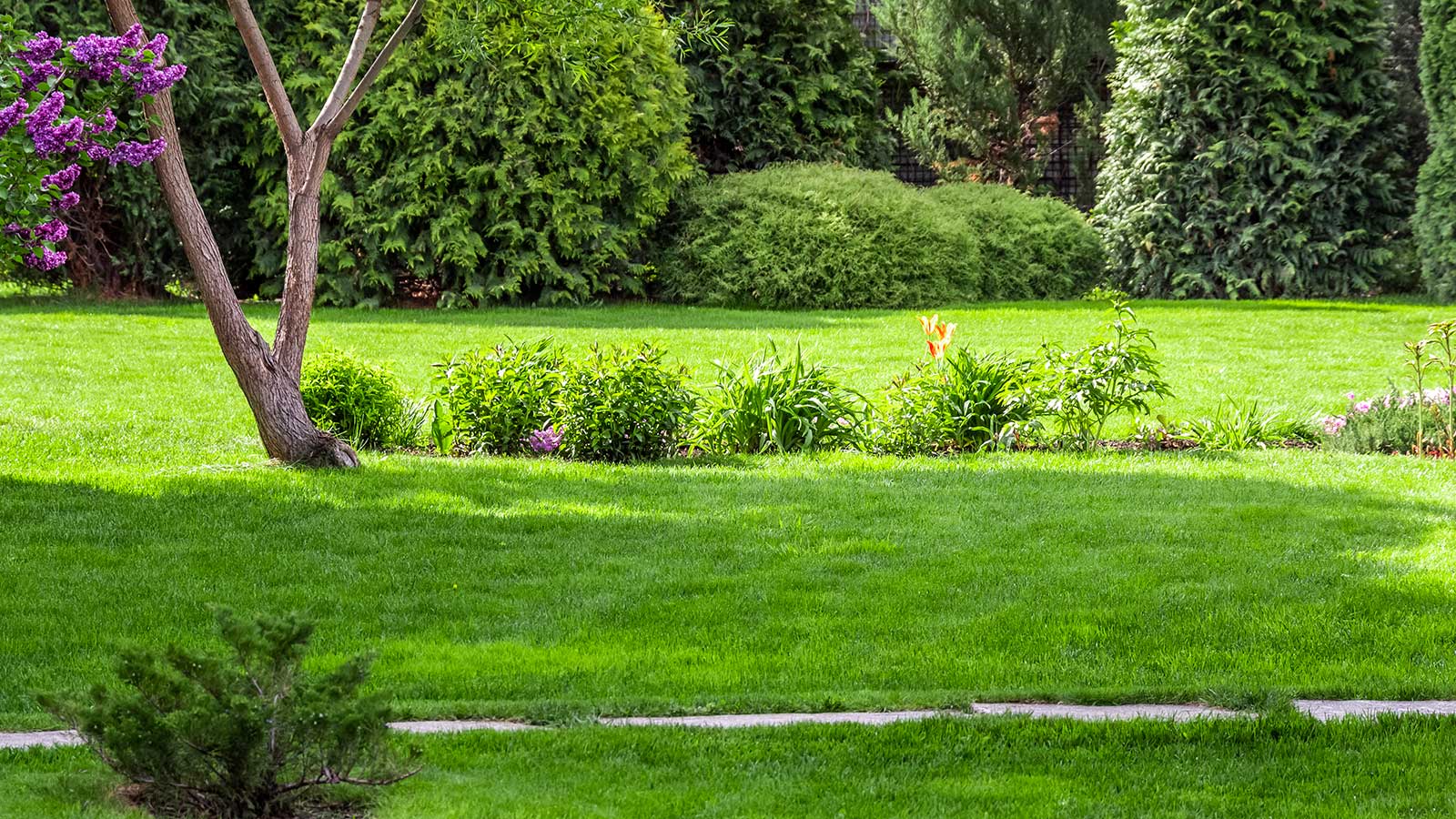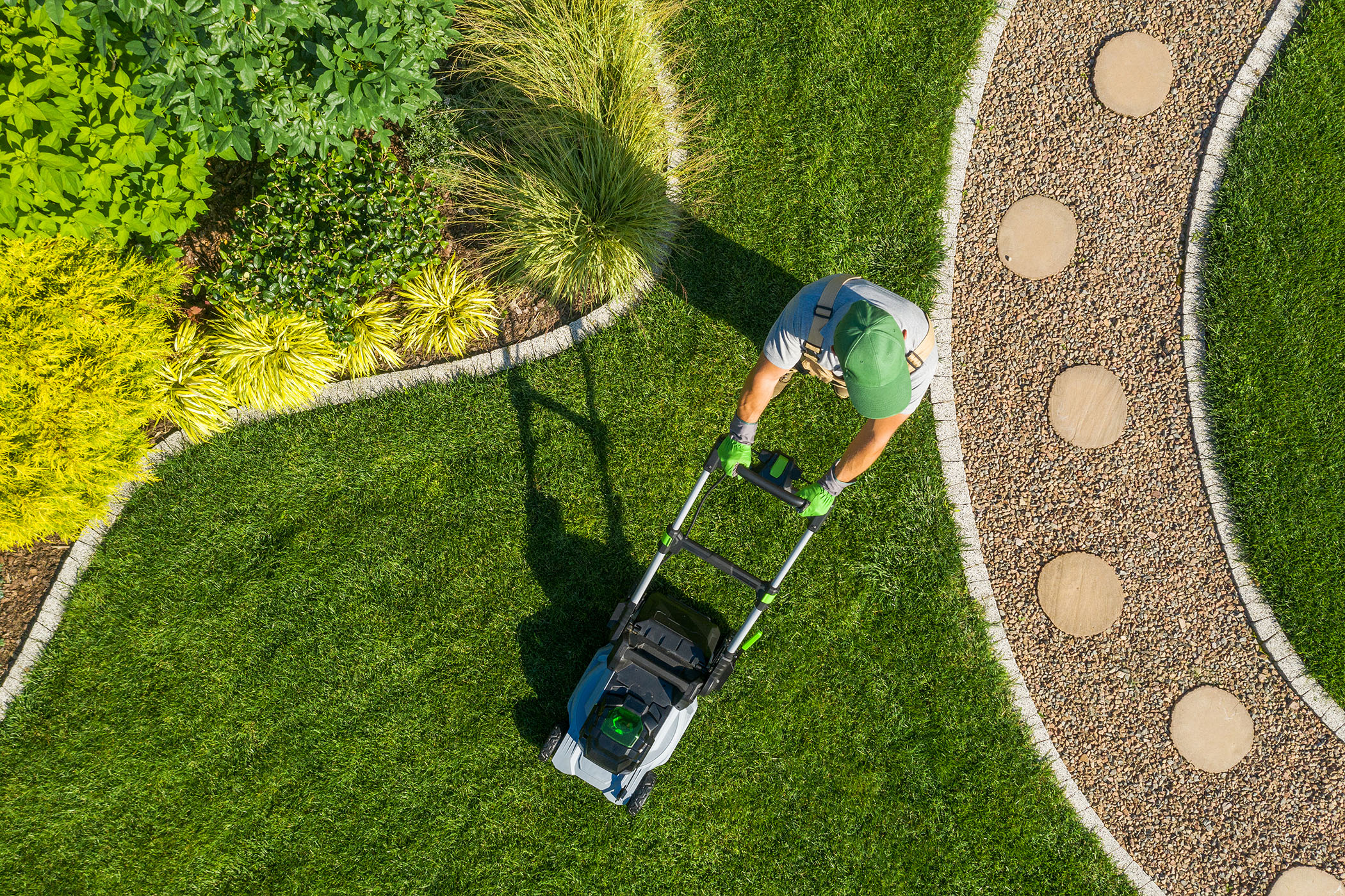
Healthy green grass can be the difference between a neglected-looking yard and one that looks inviting and lush. So, when your grass turns yellow, it's vital to discover the cause and fix it as soon as possible.
Our lawns are the focal points of our yards, so lawn care has to be at the top of our to-do lists all year round.
There is a wide range of reasons your grass can turn yellow, some in your control, and many that are out of your control. But fear not, because even these causes have solutions.
Why grass turns yellow – and how to fix it

Our gardening experts have provided their best advice for spotting potential problems causing your grass to turn yellow, and tips to help make your lawn green and thick once again.
1. You're watering your lawn incorrectly
Yellow grass can be caused by a range of factors that often indicate low nutrition in the grass. This can be caused when the lawn is over or underwatered. Lawn watering mistakes often go hand-in-hand with problems such as poor soil drainage and compacted soil.
The solutions are simple: get watering right, and know when to aerate your lawn to keep the grass healthy and green.
Testing what the issue is exactly should be an easy task: does the grass feel very wet or dry?
If it feels sodden then you will need to aerate your lawn, which will help with drainage, so that your grass' roots don't 'drown', but will receive the nutrients they need. To aerate a lawn you can simply use a pitchfork to penetrate the turf. We recommend the True Temper 1838200 6-Tine Steel Fork Pitchfork at Amazon as a reliable basic. You can also use a hand rolling aerator to do the task, such as this Safstar Rolling Lawn Aerator, or a machine powered aerator such as the BILT HARD Dethatcher Scarifier, both from Amazon.
If your grass is too dry, it will need more regular watering. A deep and infrequent watering schedule is ideal compared to a frequent shallow watering, and remember the cardinal rule: always water in the morning or late evening to minimize the amount of water that evaporates. Another reason to aerate your lawn is that it will help grass suffering in dry and compact soil. By aerating dry soil, you can increase airflow and help the grass' roots receive some much needed water.
2. The season + your soil type
For every season, there is a slightly different rule for your lawn care. Winter lawn care, like summer lawn care can be very important in preventing your grass from turning yellow.
Ruth Hayes, gardening editor at Amateur Gardening says, 'A dry spring, followed by periods of excessive rainfall during storms, puts a strain on turf. Heavy wear over summer takes its toll, too, compacting soil and weakening the grass.
'Clay soils can bake solid during hot spells, leading to sparse, yellow growth. Sandy soils present challenges as well, as nutrients leach during downpours, resulting in patchy, weak growth.'
Ruth continues, 'It has been a tough summer for lawns, and below average rainfall plus the prolonged hot, dry spells have left the grass yellow and crispy.
'It’s hardly growing so hold off the mowing until there has been some rain, then cut with the blade on the highest setting to avoid scuffing up the grass. Don’t bother watering, as your lawn will recover when it rains, and don’t feed with a spring/summer lawn fertilizer as it contains nitrogen that will cause too much soft growth that will be damaged by winter cold. Wait until fall and feed with the correct seasonal fertilizer rich in potassium and phosphates that will strengthen grass against the cold.
'The good news is that you don’t have to spend a fortune or embark on a back-breaking maintenance programme to give your lawn a quick makeover. For small areas of grass, I’ve had great results from Miracle-Gro Lawn Food (from Amazon). This high nitrogen and chelated iron feed can easily be mixed-up in a watering can and applied to the lawn.
'Lawns usually green-up in a few days, and it’s best applied when the ground is damp.'
3. Insects and pests
Insects and pests can be one of the biggest culprits when it comes to finding blame for your yellow lawn.
Ruth Hayes advises, 'Lawn problems aren’t just caused by the elements – pest larve/lawn grubs do serious damage too. Chafer grubs, active between now and spring, live underground and eat the roots of grasses.
'Chafers are summer-flying beetles that lay their eggs in lawns. The hatched grub go on to eat grass roots, killing it in patches and turning it yellow. The problem is often exacerbated by birds, foxes and badgers digging up the lawn to eat the grubs under the surface. There are no chemical controls but nematodes, at Amazon (microscopic parasitic eelworms) work well to combat the pest.
'Leatherjackets, the larvae of crane flies (daddy long-legs) are active towards the end of winter and do the same.
'Symptoms include yellow patches of dead grass and damage caused by birds digging up the lawn to get at the grubs.
'Both pests can be controlled using nematodes. Alternatively, lay carpet on the troubled area of lawn, and when the grubs come to the surface you can pick them off after lifting the carpet.'
'For lawns affected by disease or pests, investigate the appropriate fungicides or insecticides.'
4. Harmful chemicals, including pet urine
Chemicals that have come from animal urine, which contain nitrogen, aren't harmful to your lawn in small doses and can even cause these patches of grass to grow more rapidly, but in larger quantities it can cause your grass to go yellow.
To fix this problem, simply water your grass where pets or animals have urinated to dilute the nitrogen.
You should also be careful which products you are using on your lawn, if you are using a weed killer you need to be careful to kill weeds but not grass, so make sure you use specialized lawn weed killer to avoid damaging your grass, such as this Spectracide Weed Stop for Lawn, from Walmart.
5. Poor application of fertilizers
If you have been using fertilizer on your grass, this may be the root of your problem.
Whether it is that you are using too much or too little, make sure to read your fertilizer's label because not knowing how to fertilize your lawn correctly can be counter-productive to the grass's health.
Some fertilizers will advise against walking on your grass until a few days after it is fertilized. If ignored, this could explain patches of your lawn's discoloration.
You also could be using the wrong fertilizer altogether which can damage your grass.
A top tip when using grass fertilizer is to water your lawn afterwards – this will encourage the fertilizer to saturate the grass's roots, not only making it more effective but also to avoid it damaging your grass' blades.
6. Fallen leaves
Ruth Hayes, gardening editor at Amateur Gardening comments, 'It is a good idea to keep a rake handy for collecting fallen leaves that can then be stored for leaf mould or added to the compost heap. If dead leaves are left to rot down on your grass they will block the sun, which will turn it an unhealthy yellow, and provide a damp breeding ground for pests and diseases'.
7. Fungus
Anne Swithinbank, gardening expert and writer suggests, when your lawn has turned yellow in the appearance of a fairy ring, 'the culprit here is usually a fungus called Marasmius oreades, also known as Scotch bonnet, although there are others that create rings. They arrive as spores, and as the underground hyphal strands known as mycelium grow outwards, water is repelled, creating yellowing grass.
'The mycelium feeds on organic matter in the soil rather than the grass itself, but has an effect on soil nutrients, with poorer areas of depleted nitrogen, and commonly a circle of rich green grass where extra nitrogen has boosted growth. Adding insult to injury, toadstools appear during late summer or fall to decorate and highlight the ring.
'My usual advice for small lawns is to let the fairy ring expand and fall off the edges naturally. For larger ones, allow the infected section to develop as a meadow to disguise the ring.
'Where fairy rings occur in larger grassy areas, a meadow with mown pathways will conceal the ring and create a rich habitat.
'Spiking, watering and feeding the dry, yellow parts of a fairy ring where the mycelium is growing will help it to blend in with the rest of the lawn.'
8. You're cutting with blunt lawnmover blades

Grass can also be turned yellow by improper lawn mower conditions such as blunt blades. This is because blunt blades will tear the grass rather than slice it which creates a wound on the grass blades which make them more vulnerable to diseases or to dry out, both of which can cause your grass to turn yellow. So, lawnmower maintenance is a must.
9. Cutting grass too short
Surprisingly, it is actually possible to damage your lawn and turn it yellow simply by cutting it too short.
Drew Swainston, gardening expert at Homes & Gardens advises, 'Mowing too short can cause grass to turn yellow, so never take more than one-third of the length off anytime you go out with your lawnmower. Cutting too short will cause the grass to display yellow patches as it struggles from being left without enough moisture. It will be stressed and left at increased risk of falling foul of hot temperatures or pests and diseases.
'Adjust the height of your mowing so you are never taking too much off, and if you do want to take down very tall grass it is better to do it in staggered stages rather then trying to do it all in one mow.'
FAQs
Can you use compost to fix the yellow grass color?
Yes, compost is actually a great way to help you turn your yellow grass back to green. Compost, just like fertilizer, is a great way to improve the pH levels in your soil and restore nutrients to the soil that it is lacking, leading to your grass' yellow state. Persist Green Bull Lawn and Garden Fertilizer is highly rated at Amazon.
Any signs of grass discoloration can point to a larger problem, so if you suspect something is wrong with your grass make sure to check the possible problems so you can fix them as soon as possible.
In summer, grass can quickly turn yellow due to the heat trying it out, so make sure to give it some good watering in the early morning or late evening to make sure it stays hydrated and green. However, if watering is restricted or the weather extremely hot, don't worry: even the persistently yellow of grass will usually recover once cooler, wetter weather arrives.







